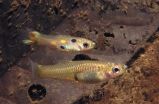Diversifying the herbicide mechanisms of action (MOAs) has been recommended to stop the spread of herbicide-resistant weeds. MOAs refer to the biochemical interaction that affects or disrupts the target site in the weed. Two common methods of diversifying MOAs involve rotating herbicides--from season to season or within the same season--or by using a mix of herbicides in the same tank. The question has been which of these methods is the most effective.
A recently published study by weed scientists at the University of Illinois and USDA-ARS, looking at glyphosate-resistant waterhemp, is providing valuable evidence that points to management practices as the driving force behind herbicide resistance, and that herbicide mixing, as opposed to herbicide rotation, is the most effective tool in managing resistance.
Pat Tranel, a U of I weed scientist and a co-author on the study, said this is not the first time researchers have presented evidence that herbicide rotation is not the best resistance management strategy. "This paper is valuable because these conclusions were obtained doing our experiment in a more 'real-life' fashion," Tranel said. "This study confirmed previous conclusions that farmers should use herbicide mixing rather than rotation."
During the study, the researchers evaluated glyphosate-resistance incidences, as well as landscape, soil, weed, and farm-management data from 105 central Illinois grain farms, including almost 500 site-years of herbicide application records. Having this data, collected between 2004 and 2010, helped the researchers identify relationships between past herbicide use and current glyphosate-resistance occurrences.
Tranel said when glyphosate-resistant waterhemp was first reported in Illinois in 2006, researchers working at the site saw some fields that were infested with waterhemp, but adjacent fields that were free of the weed.
"We asked, 'what is different between these two fields? Is it what the farmers are doing?' We asked a retail applicator to let us review all the management practices data from 100 fields--50 that have resistant waterhemp and 50 that don't," Tranel said.
"We took the results of what farmers have already done, and asked what is different in the fields that have resistance versus the ones that don't," he added.
After collecting the management data, sampling waterhemp from the fields, and screening seeds from the field for resistance back in their greenhouses, the researchers analyzed that data for management factors most associated with resistance. Overall the researchers examined 66 variables related to environment, soil, landscape, weed community, and weed management.
"We looked at every factor we could think of in terms of management and landscape," Tranel said. "We found that it was management factors that are the most important. It doesn't matter whether you're next to a water course that might bring in new seed, what the waterhemp density of your field is, etc. It's what you did in your field that matters.
"That's what's encouraging," he added. "It's not inevitable that if your field is next to a water course, for example, you will have resistance."
Aaron Hager, a U of I weed scientist and co-author on the study, explained that the occurrence of glyphosate-resistant waterhemp was greatest in fields where glyphosate had been used in over 75 percent of the seasons included in the analysis, where fewer MOAs were used each year, and where herbicide rotation occurred annually. "Simply rotating herbicide MOAs actually increased the frequency of resistance," he said.
On the other hand, Tranel said that the farmers who were using multiple herbicides per application were least likely to have resistance. "When using an average of 2.5 MOAs per application, you are 83 times less likely to have resistance compared to if you used only 1.5 MOAs per application," he explained.
"That's pretty amazing that adding one additional mode of action in your tank reduces your chances of resistance by that much," Tranel added.
Hager pointed out that this strategy will work only if each component of the tank mixture is effective against the target species. "Effective, long-term weed management will require even more diverse management practices," he added.
Another piece of good news for farmers is that the researchers did not find an association of proximity between neighboring fields and resistance. "The good thing is not only does management matter, it's what you do in your own field that matters. Even if a neighbor's resistance moves, it's at a small frequency. If you're doing the right thing it will stay at a small frequency," Tranel said.
Although there may be some concerns with herbicide mixing, Tranel said it is still the best tool to manage resistance. One concern is the greater expense and environmental load of using multiple herbicides.
Another concern is using the correct mix of herbicides in the tank. Particularly as waterhemp becomes resistant to other herbicides, such as PPO inhibitors, mixing glyphosate and a PPO inhibitor, is not going to be a good management strategy if there is already resistance to a PPO inhibitor, Tranel explained.
"As we have new tools coming like 2,4-D and dicamba-tolerant soybeans, some people may think 'I'll throw in 2,4-D with glyphosate, because that's using two modes of actions,' but if you already have glyphosate resistance then you are not really using two effective modes of action," he added.
"We don't say that mixing is the end-all solution. What we saw from this study if success for farmers is measured by lack of resistance or lower frequency, then successful farmers use multiple herbicides per application."
INFORMATION:
"Managing the evolution of herbicide resistance" was recently published in Pest Management Science and is available online at http://onlinelibrary.wiley.com/journal/10.1002/(ISSN)1526-4998/earlyview.
Co-authors of the study include Jeffrey A. Evans, Patrick J. Tranel, Aaron G. Hager, Brian Schutte, Chenxi Wu, Laura A. Chatham, and Adam S. Davis.
Funding for the study was provided by USDA-NIFA, USDA-ARS, Monsanto Co., and the Illinois Soybean Association and Soybean Checkoff.

